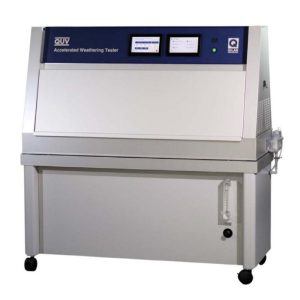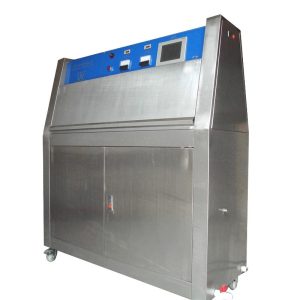การใช้กล่องทดสอบการเสื่อมสภาพของรังสียูวีในเซรามิกและมาตรฐานที่เกี่ยวข้อง
โดยปกติแล้ว เซรามิกไม่จำเป็นต้องผ่านการทดสอบการเสื่อมสภาพของรังสียูวี เนื่องจากตัวเซรามิกเองมีความทนทานต่อสภาพอากาศและความทนทานที่ดี. เมื่อเทียบกับวัสดุอื่นๆ (เช่นพลาสติก, การเคลือบ, ฯลฯ), เซรามิกมีความไวต่อรังสียูวีน้อยกว่าและไม่ได้รับผลกระทบจากรังสียูวีได้ง่าย. เซรามิกโดยทั่วไปมีความคงตัวทางเคมีและความร้อนสูง และสามารถรักษาคุณสมบัติและรูปลักษณ์ไว้ได้เป็นเวลานานภายใต้สภาพแวดล้อมที่หลากหลาย.
อย่างไรก็ตาม, ในกรณีการใช้งานพิเศษ, เช่นการเคลือบเซรามิกหรือวัสดุเซรามิกชนิดพิเศษ (เช่นกระจก, ฯลฯ), อาจต้องทำการทดสอบอายุรังสียูวีเพื่อประเมินความทนทานต่อสภาพอากาศและความเสถียรด้านประสิทธิภาพ. ในกรณีนี้, การทดสอบอายุของรังสียูวีสามารถจำลองการสัมผัสของวัสดุเซรามิกในสภาพแวดล้อมกลางแจ้งเพื่อประเมินความต้านทานรังสียูวี, ทนต่อสารเคมี, ความต้านทานต่อการขัดถูและคุณสมบัติอื่น ๆ.

การใช้กล่องทดสอบการเสื่อมสภาพของรังสียูวีในเซรามิกและมาตรฐานที่เกี่ยวข้อง
มาตรฐานอุตสาหกรรม
The standards of ceramics usually cover the physical properties of materials, chemical properties, คุณสมบัติทางกล, dimensional requirements, and requirements for specific application areas. The following are some common industry standards and specifications that apply to different types of ceramic materials:
ASTM C242: Standard specification for Ceramic Tiles
ASTM C373: Standard Test Method for Water Resistance of Ceramics and Glass
ไอเอสโอ 10545 series: International standards for the physical and mechanical properties of ceramic tiles and ceramic plates
ไอเอสโอ 13006: International standard for product definitions, dimensions and tolerances for ceramic tiles and stone tiles
ไอเอสโอ 27447: International standard for wear resistance of ceramic tiles
กิกะไบต์/ที 3810.6: Chinese national standard for physical and mechanical properties of ceramic tiles
กิกะไบต์/ที 6566: Chinese national standard for determination of radioactive elements in ceramic products
These standards are usually developed and published by international standards organizations (เช่น ASTM, ไอเอสโอ) or standardization bodies in various countries (such as the National Standards Committee of China). The specific standards should be selected according to the type and application field of ceramic materials.

การใช้กล่องทดสอบการเสื่อมสภาพของรังสียูวีในเซรามิกและมาตรฐานที่เกี่ยวข้อง
กรณีการสมัคร
The following are some specific application cases of ceramics:
Construction field: Ceramic tiles and ceramic plates are widely used for decoration and covering of floors, walls, bathrooms, kitchens, ฯลฯ, both indoor and outdoor. Ceramic tiles are wear-resistant, water-resistant, and easy to clean, making them suitable for high traffic volume areas and humid environments.
Medical instruments: Ceramics are used in manufacturing medical instruments and devices such as dental restorative materials, artificial bones and joints, dental implants, และคนอื่น ๆ. Ceramics have the advantages of biocompatibility, ความต้านทานการกัดกร่อน, and mechanical strength in the medical field.
Electronics: Ceramic materials are used in the manufacturing of electronic components and devices, such as ceramic capacitors, ceramic media, ceramic insulators, ฯลฯ. Ceramics have good insulation properties, high temperature resistance and chemical stability in the field of electronics.
การคุ้มครองสิ่งแวดล้อม: Ceramics can be used for environmental treatment and pollution control, such as ceramic filter media and ceramic membrane for water treatment, gas purification and solid waste treatment.
Art and decoration: As an art and decorative material, ceramics are used to make pottery, ceramic sculptures, ceramic utensils, tile murals, ฯลฯ.
Ceramic coatings: Ceramic coatings are applied to metals, พลาสติก, or other substrates to provide properties such as resistance to wear, การกัดกร่อน, heat conduction, or insulation. For instance, ceramic coatings are used in areas such as automotive engine parts, cutting tools, stoves, ฯลฯ.
These application cases are only a small part of the application fields of ceramics, and the practical application can be more customized and expanded according to different industries and needs. As a multifunctional material, ceramic has a wide application prospect.
